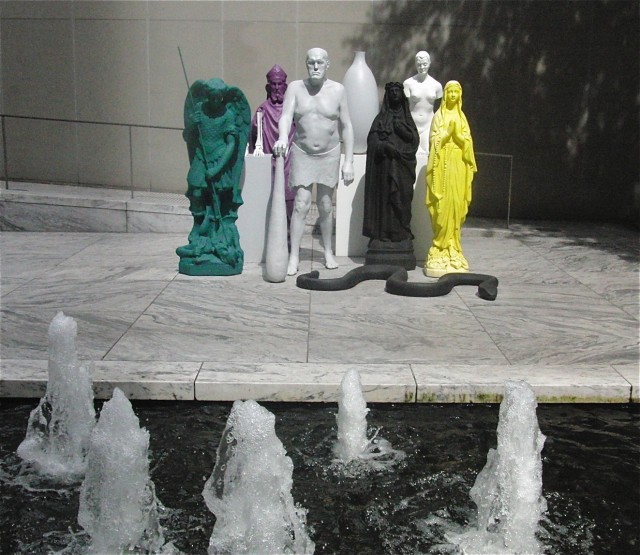
Katharina Fritsch’s “Group of Figures” is back in MoMA’s Abby Aldrich Rockefeller Sculpture Garden, which is now open for free every morning from 9:00 to 10:30 (photo by twi-ny/mdr)
Museum of Modern Art
The Abby Aldrich Rockefeller Sculpture Garden
West 54th St. between Fifth & Sixth Aves.
Early hours: open daily 9:00 – 10:30 am, free
www.moma.org
Designed in 1953 by architect Philip Johnson, the Abby Aldrich Rockefeller Sculpture Garden resides on the site that was once the town-house home of Abby Aldrich Rockefeller, one of the founders of the Museum of Modern Art. A socialite and philanthropist who married John D. Rockefeller Jr. in 1901, Aldrich was the mother of Abby, John III, Nelson, Laurance, Winthrop, and David Rockefeller. The garden has been one of the great, peaceful respites of New York City for sixty years, its multiple levels and reflecting pools, which Johnson called “canals,” along with its birches and beeches, offering visitors a beautiful space to commune with both art and nature en plein air. Beginning September 9, the sculpture garden will be open for free starting at 9:00 each morning, ninety minutes before the rest of the museum opens to paying customers. Early risers can buy coffee and other drinks and enjoy the garden’s current arrangement of sculptures, “The Modern Monument,” which consists of old favorites as well as newer delights. Walking around the garden, one will encounter Alberto Giacometti’s “Tall Figure, III,” Jenny Holzer’s “Granite Bench,” Joan Miró’s “Moonbird,” Barnett Newman’s “Broken Obelisk,” and Pablo Picasso’s “She-Goat.” Aristide Maillol’s “The River” still dangles over one of the pools, while Hector Guimard’s “Entrance Gate to Paris Subway (Métropolitain) Station, Paris, France” stands in its longtime space at the far east end and Henri Matisse’s stunning quartet, “The Back,” lines its usual wall, celebrating the human body. Also on view are Mark di Suvero’s “For Roebling,” Tony Smith’s “Die,” Claes Oldenburg’s “Geometric Mouse, Scale A,” Picasso’s “Monument,” and Katharina Fritsch’s colorful “Group of Figures.” The most recent addition to the garden is Stephen Vitiello’s audiovisual installation “A Bell for Every Minute,” which was created for the High Line and now resides outside at MoMA, a collection of different bells from around the city chiming minute after minute. In 2004, when the museum returned to Midtown after a major renovation and expansion (and temporary move to Queens), architect Yoshio Taniguchi restored the garden to its original dimensions, explaining that it is “perhaps the most distinctive single element of the museum today.” And now entrance to this most distinctive element is free every morning from 9:00 to 10:30.